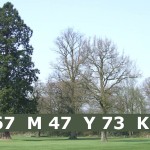
It’s that time of year when most leaves on trees have either colored or fallen completely from their branches. The exceptions are, of course, evergreen trees. As seen in the accompanying image, evergreen trees stand out in the fall and winter next to the bare branches of their cousin trees.
The life of a leaf
Deciduous trees are ones that drop their leaves in the colder – but more importantly less lighted – months. In warmer months with lots of sunshine and high humidity, leaves remain green as they collect sunlight and go through photosynthesis. The chlorophyll used during this process is what makes the leaves keep their green color. As sunlight wanes in colder seasons, less and less photosynthesis is occurring and the leaves begin to lose their green and turn different colors as they “die.” Eventually, they become so unnecessary that the tree drops them from its branches completely.
However, the job of a leaf doesn’t actually end there. When it falls from a tree onto its roots, it joins thousands of others and together they break down into a kind of compost to supply nutrients to the soil and then to the tree. This not only allows the tree to survive a harsh winter; but provides the nutrition necessary for the tree to produce thousands more leaves in the spring so that the photosynthesis process can begin again. Deciduous trees enter a kind of dormancy period while they wait for warmer months.
Why evergreens retain color year-round
Most evergreen trees are coniferous – or cone-bearing. Their “leaves” are very different from deciduous trees to the point that they aren’t considered leaves at all. They are more like needles and they have many benefits that help a tree retain their color.
Evergreen needles are narrower and more compact than deciduous broad leaves. This and their wax-like covering allows them to retain more water so that they can photosynthesize year-round and, therefore, keep their color. Evergreens replace their needles slowly throughout the year. They need less soil nutrition than deciduous trees.
But evergreens aren’t always green
You may notice that in the section above, we said that evergreens “retain their color” and not that they “remain green.” That’s because the botany term “evergreen” isn’t actually accurate in the sense that these trees and bushes are all green in color.
Evergreens come in a variety of colors such as blue-green, yellow gold or chartreuse. Some evergreens can even change color in autumn and winter due to colder temperatures just like deciduous trees. Why then are they referred to as evergreens?
The true definition of an evergreen is simply a tree or bush that retains its leaves (or needles) year-round. Just for fun, click here for a landscape photo of a variety of different colored evergreens. Interestingly, color has nothing to do with being an evergreen.

oddly, when i create that CMYK tint in Photoshop and then change from the Picker to Color Libraries – Photoshop selected Pantone 418 – a yellowish grey.
Interesting. When I input it, I get closer to 554, a more greenish like I have in the image. Yet, I suppose this goes along with the post right? Evergreen doesn’t mean green….
Thanks for linking me guys! Cool site!! 🙂
– Nicole @ The Roaming Naturalist
theroamingnaturalist.com